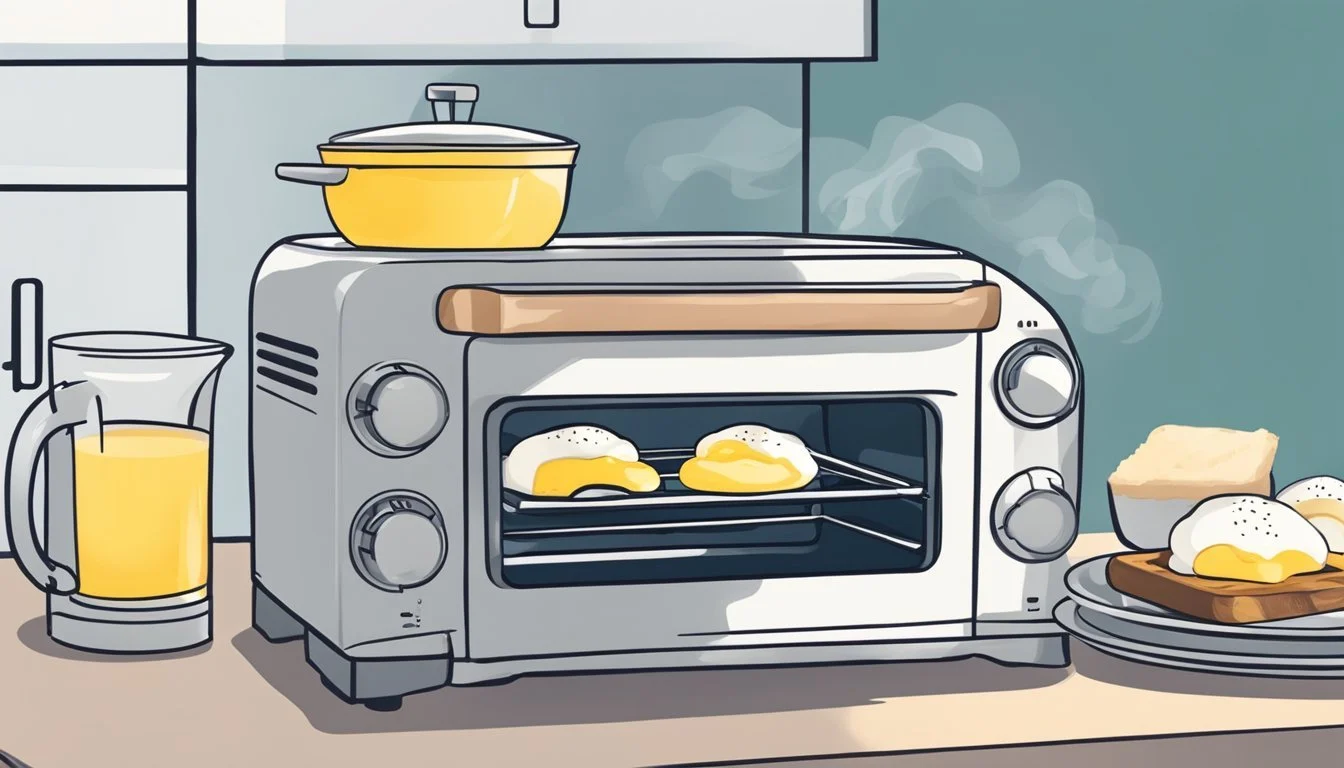How to Reheat Eggs Benedict: Easy Methods for Perfect Flavor
Introduction to Reheating Eggs Benedict
Reheating Eggs Benedict can be a delicate process, as it requires careful attention to each component to maintain the dish’s integrity. The key to successfully reheating Eggs Benedict is to understand the best methods for warming the hollandaise sauce, English muffins, Canadian bacon, and poached eggs. By using the right techniques, you can enjoy a delicious and satisfying breakfast or brunch dish that is sure to impress. In this section, we will explore the basics of reheating Eggs Benedict and provide tips for achieving perfectly poached eggs, crispy English muffins, and a smooth and velvety hollandaise sauce.
Best Methods and Tips
Eggs Benedict is a beloved breakfast classic that combines poached eggs, Canadian bacon slices, and buttery hollandaise sauce atop a toasted English muffin. Reheating this dish while preserving its delicate flavors and textures can be a bit tricky. The key to perfectly reheated Eggs Benedict is to use gentle heat, whether you choose the microwave, oven, or stovetop method.
For those who find themselves with leftovers from a luxurious brunch, knowing the correct way to warm them up ensures the dish maintains its original taste and quality. Placing the Eggs Benedict in a microwave-safe dish and covering it helps retain moisture, making sure the eggs remain tender and the components heat evenly without drying out.
Exploring different reheating techniques like the microwave, oven, or stovetop will ensure you get the best results. Each method requires careful attention to maintain the dish’s integrity, particularly concerning the delicate hollandaise sauce and poached eggs.
Understanding Eggs Benedict
Eggs Benedict is a cherished breakfast or brunch dish known for its rich and indulgent flavors. This dish typically consists of an English muffin halved and toasted to a crisp texture. On top of the muffin, you will often find slices of either ham or Canadian bacon. Both meats add a savory taste that complements the other elements. Poached eggs are placed on the meat. These eggs have a delicate, runny yolk encased in a firm yet tender white.
The final flourish is a generous drizzle of Hollandaise sauce. This creamy sauce is made of egg yolks, butter, and lemon juice, and it brings a luxurious touch to the dish. Adding dijon mustard to the hollandaise sauce can enhance its tangy flavor, making the dish even more delightful.
Eggs Benedict is popular for both breakfast and brunch due to its sophisticated and satisfying combination of flavors. This dish can be enjoyed as a main course at a leisurely weekend brunch or a special breakfast treat.
Storing Eggs Benedict
Proper storage of Eggs Benedict is essential to maintain its flavors and textures. Knowing how to refrigerate or freeze leftovers effectively can help in preventing bacteria growth and preserving the dish for later enjoyment.
Additionally, considering 'make ahead eggs benedict' allows you to prepare components in advance, making it easier to serve this beloved brunch dish during special occasions or gatherings without the stress of last-minute preparation.
Refrigeration Best Practices
When storing Eggs Benedict in the refrigerator, ensure it is in an airtight container to prevent exposure to air, which can dry out the ingredients. Wrap the Eggs Benedict tightly in cling wrap before placing it in the container.
Store leftovers within two hours of cooking to limit bacteria growth. Place them on the middle shelf of the fridge, where the temperature is most consistent. Labeling containers with the date helps in keeping track of freshness. Eggs Benedict can be refrigerated for up to three days.
Freezing Techniques
Freezing Eggs Benedict can extend its shelf life but requires careful preparation to maintain quality. Wrap each component separately. For instance, wrap poached eggs and English muffins in cling wrap, then place them in freezer-safe containers.
Use freezer bags for the hollandaise sauce, squeezing out as much air as possible to prevent freezer burn. Label each package with the date and use within one month. Thaw frozen Eggs Benedict in the refrigerator overnight before reheating. Avoid leaving it at room temperature, as this can promote bacteria growth.
Preparation for Reheating
When it comes to reheating Eggs Benedict, proper preparation ensures that the flavors and textures are preserved. Focus on preparing the Hollandaise sauce and separating the components for optimal results.
It's crucial to properly cook the egg whites to avoid them becoming rubbery during reheating.
Preparing the Hollandaise Sauce
Reheating Hollandaise sauce requires a gentle touch to maintain its creamy texture and rich flavor. To reheat hollandaise sauce, begin by placing the Hollandaise sauce in a microwave-safe bowl. Cover the bowl with a microwave-safe lid or plastic wrap, leaving a small vent for steam to escape.
Microwave on low power for 15-20 seconds at a time, stirring in between intervals. This prevents the sauce from curdling. Alternatively, you can reheat the sauce in a double boiler. Place the sauce in a heatproof bowl over a pot of simmering water, stirring constantly until it warms up.
Avoid direct heat as it can overcook and thicken the sauce too much, affecting the moisture and texture.
Separating the Components
To achieve the perfect reheat, each component of the Eggs Benedict should be prepared individually. Begin by separating the poached eggs, English muffins, and bacon.
English Muffins and Bacon: Place the English muffins and bacon on a baking sheet. Reheat in a preheated oven at 350°F for about 5-7 minutes until they are warm and crispy. This prevents the muffins from becoming soggy and ensures the bacon retains its crisp texture.
Poached Eggs: Gently reheat the poached eggs by submerging them in a pot of simmering water for 15-20 seconds. Avoid boiling water as it can overcook the eggs and ruin the delicate texture. After cooking, place the poached eggs on a paper towel lined plate to absorb excess water before reheating.
The careful separation and individual reheating of each component help maintain the flavor and quality of the leftover Eggs Benedict.
Reheating Methods Overview
Reheating Eggs Benedict requires careful consideration to maintain its texture and flavor. Below are detailed methods for using a microwave, oven, and stovetop to reheat this classic dish effectively.
Using medium heat is crucial to avoid overheating and to maintain the texture of the components, especially when reheating delicate items like English muffins and hollandaise sauce.
Microwave Method
Using the microwave is the quickest way to reheat Eggs Benedict. Begin by placing your Eggs Benedict in a microwave-safe dish. To retain moisture and prevent the poached egg from becoming rubbery, cover it with a lid or a paper towel.
Set the microwave to high and heat for about one minute. Check if it is warm enough; if not, increment in 15-second intervals until done. Be careful not to overcook, as excessive heat can dry out the eggs and make the hollandaise sauce separate.
Once reheated, spoon hollandaise sauce over the Eggs Benedict as a finishing touch.
Oven Method
The oven method is ideal for reheating larger portions and retaining the original texture. Preheat your oven to 375°F (190°C). Place the Eggs Benedict on a baking sheet lined with parchment paper or foil to avoid sticking.
To achieve a crispy texture, it is important to toast English muffins before reheating. Cover with foil to keep moisture in and bake for around 10-15 minutes. Check if it’s heated through to your liking. This method prevents the eggs from becoming tough and keeps the hollandaise sauce creamy.
Stovetop Method
Reheating Eggs Benedict on the stovetop offers a balanced approach. Start by filling a saucepan with about an inch of water and bring it to a low simmer. Place the Eggs Benedict on a skillet or a heatproof plate.
Cover with a lid to create a steaming effect, which gently reheats the eggs without overcooking. Heat for 5-7 minutes, checking periodically. This method ensures the poached egg stays tender, and the sauce remains smooth.
These methods, when followed carefully, help you enjoy your leftover Eggs Benedict as close to its original state as possible.
Step-by-Step Guide to Reheating
Reheating Eggs Benedict can be done efficiently using different methods: microwave, oven, or stovetop. Each method has specific steps to ensure even heating and to avoid moisture loss.
Microwave Reheating Guide
To reheat Eggs Benedict in the microwave, start by placing it in a microwave-safe dish. Adding a lid will help retain moisture. Set the microwave to low power to prevent overcooking, which can dry out the eggs.
Prepare The Dish: Place Eggs Benedict on the dish and cover it.
Heat On Low: Microwave on low power for about 1 minute.
Check and Reheat: Check the temperature; if needed, heat in 10-second intervals until warm.
The hollandaise sauce can be reheated separately in the microwave by stirring every few seconds to maintain a smooth consistency.
Oven Reheating Instructions
Using the oven ensures even heating, reducing the chances of overcooking. Preheating the oven to 350°F (175°C) is crucial for this method.
Preheat The Oven: Set the oven to preheat at 350°F.
Prepare a Baking Pan: Place the Eggs Benedict on a baking pan or a baking dish.
Cover and Heat: Cover with aluminum foil to trap moisture. Heat for about 15 minutes.
Check and Serve: Check the warmth and serve once it reaches the desired temperature.
For enhanced flavor and texture, brush olive oil on the English muffins and bacon before reheating.
Reheat the hollandaise sauce separately on the stovetop over low heat, stirring to avoid separation.
Stovetop Reheating Technique
This method uses steaming to ensure moisture retention, preventing the eggs from becoming rubbery.
Water Bath Setup: Bring a small pot of water to a simmer. Use a double boiler or place a heatproof bowl over the pot.
Reheat Eggs: Place the Eggs Benedict in the heatproof bowl, cover, and steam for 3-5 minutes.
Separate Components: Heat the ham and English muffin separately in a skillet for even heating.
For the hollandaise sauce, a double boiler works well to reheat without curdling, stirring consistently.
Each of these methods helps maintain the integrity of the delicate components, providing a satisfying reheated Eggs Benedict.
Preventing Common Reheating Issues
When reheating Eggs Benedict, it is essential to focus on avoiding overcooked eggs and maintaining appropriate moisture levels. These considerations help preserve the dish’s texture and flavor.
Using a slotted spoon is crucial for gently handling poached eggs during reheating, ensuring the whites are set and the yolks remain runny while draining excess water before serving.
Avoiding Overcooking
Overcooked eggs can become dry and rubbery. To prevent this, use precise reheating methods. Microwave ovens can be convenient if used properly: place Eggs Benedict in a microwave-safe dish, cover with a lid, and heat for only one minute on high.
Alternatively, the double boiler method is effective for gentle heating. Place the eggs in a heatproof bowl over simmering water and steam for 3-5 minutes. This method ensures even heating without overcooking. Always avoid boiling the contents to protect their delicate structure.
Managing Moisture Levels
Maintaining moisture is critical for reheating Eggs Benedict. Covering dishes during reheating helps retain steam and moisture. The hollandaise sauce can be warmed separately and should be stirred constantly over low heat to prevent separation.
Reheating the ham and English muffin separately in a pan helps them retain their texture. For poached eggs, a dip in boiling water for about 15 seconds can reheat them without drying. Balance moisture levels to ensure the dish remains appetizing and flavorful.
Serving and Garnishing Reheated Eggs Benedict
When reheating Eggs Benedict, it’s crucial to serve it promptly with appealing garnishes and sides to enhance both presentation and flavor. Consider adding green onions as a garnish to enhance the dish's flavor and presentation.
Garnishes and Accompaniments
Garnishes:
Fresh Herbs: Add a burst of color and freshness with chopped chives, parsley, or dill. Sprinkle these lightly over the top of the Eggs Benedict.
Smoked Salmon: Thin slices of smoked salmon can be draped over the eggs, adding a rich, smoky flavor.
Spinach: For a healthful touch, place a few fresh spinach leaves around the plate or as a base layer under the eggs.
Accompaniments:
Roasted Potatoes: Serve alongside crispy roasted potatoes, seasoned with rosemary and garlic for a satisfying addition.
Asparagus: Steamed or grilled asparagus spears make a sophisticated side.
Hollandaise Sauce: Ensure extra hollandaise sauce is warmed and drizzled generously over the plated Eggs Benedict.
These garnishes and accompaniments not only elevate the dish visually but also complement the flavors of the Eggs Benedict.
Additional Tips for Success
Reheating Eggs Benedict can be tricky, but a few tips can make the process smoother and tastier.
Reheat Components Separately: To avoid overcooking, reheat the eggs, sauce, and any additional ingredients like sautéed spinach separately.
Use Low Power Settings: When using a microwave, employ low power settings to gently reheat components. This helps maintain texture and flavor.
Toaster Oven Method: A toaster oven is great for reheating English muffins and Canadian bacon. Preheat to a low temperature and heat for a few minutes until warm.
Freshly Made Hollandaise Sauce: If the hollandaise sauce has separated, consider making a fresh batch. Alternatively, whisk in a little warm water or lemon juice to bring it back together.
Stir Constantly: If reheating hollandaise sauce on the stove, use low heat and stir constantly to avoid curdling.
Recipes Variation: For variations like Eggs Florentine, reheat sautéed spinach on the stove. This can be added to your dish just before serving.
By following these tips, reheated Eggs Benedict can taste almost as good as freshly made. These insights come from a seasoned recipe developer, ensuring your dish retains its deliciousness.
Variations of Eggs Benedict
Eggs Benedict is a versatile dish that allows for various ingredients and adaptations to cater to different tastes and dietary needs. By altering core components like the ham and English muffin, or by making adjustments for specific diets, it’s possible to create a unique version of this classic breakfast favorite.
For a unique twist, consider using sliced tomatoes paired with fresh mozzarella and basil to create an Italian-inspired variation.
Alternative Ingredients
Traditional Eggs Benedict features poached eggs, ham, and an English muffin topped with hollandaise sauce. Salmon can be used in place of ham for a lighter, more delicate flavor, creating what's known as "Eggs Royale." For a heartier option, crispy bacon or sausage patties can be substituted.
Instead of the usual poached eggs, some variations use scrambled eggs. This may be preferable for those who find poached eggs too runny. Additionally, consider swapping the English muffin for different bread options like sourdough toast, bagels, or even waffles
Adapting for Special Diets
For those on a gluten-free diet, English muffins made from gluten-free flour are an excellent option. Alternatively, portobello mushroom caps can serve as a flavorful and healthy base.
Vegetarians can replace meat with options like spinach and tomato slices. Avocado is another popular substitution, providing a creamy, nutritious alternative to traditional meats.
If following a paleo or keto diet, use almond flour bread or simply serve the components over a bed of spinach or other leafy greens.
By exploring these ingredient substitutions and dietary adaptations, Eggs Benedict can be enjoyed by a broader audience, ensuring everyone has the opportunity to savor this classic dish.
Make-Ahead and Leftovers
Making Eggs Benedict ahead of time can be a great way to simplify your breakfast or brunch routine. By preparing the hollandaise sauce, cooking the Canadian bacon, and poaching the eggs in advance, you can assemble the dish quickly and easily in the morning. When it comes to leftovers, it’s essential to store each component separately to maintain their texture and flavor. The hollandaise sauce can be stored in an airtight container in the refrigerator for up to 3 days, while the poached eggs can be stored in an ice bath for up to 2 hours. By following these make-ahead and leftover tips, you can enjoy delicious Eggs Benedict all week long.
Classic Eggs Benedict Recipe
The classic Eggs Benedict recipe consists of toasted English muffins, Canadian bacon, poached eggs, and hollandaise sauce. To make this recipe, start by toasting the English muffins and cooking the Canadian bacon. Next, poach the eggs by cracking them into a pot of simmering water and cooking for 3-4 minutes. Meanwhile, prepare the hollandaise sauce by combining egg yolks, lemon juice, and melted butter in a blender. Assemble the dish by placing a toasted English muffin half on a plate, topping with a slice of Canadian bacon, a poached egg, and a spoonful of hollandaise sauce. This classic recipe is a great starting point for creating your own Eggs Benedict variations, such as adding sliced avocado or smoked salmon.
Blender Hollandaise Sauce Recipe
The blender hollandaise sauce recipe is a quick and easy way to make this classic sauce. By combining egg yolks, lemon juice, and melted butter in a blender, you can create a smooth and velvety texture in just a few minutes. To make this recipe, start by melting the butter in a microwave-safe bowl. Next, combine the egg yolks, lemon juice, and cayenne pepper in a blender. With the blender running, slowly pour in the melted butter until the sauce is smooth and emulsified. Season with salt and pepper to taste, and serve immediately. This blender hollandaise sauce recipe is a game-changer for making Eggs Benedict at home.
Eggs Benedict Recipe Inspiration
Eggs Benedict is a versatile dish that can be inspired by a variety of flavors and ingredients. For example, you can add sliced smoked salmon or thinly sliced ham to create a unique twist on the classic recipe. You can also experiment with different types of cheese, such as cream cheese or fresh mozzarella, to add an extra layer of flavor. Additionally, you can serve Eggs Benedict with a side of crispy hash browns or roasted vegetables to add some crunch and texture to the dish. By getting creative with your Eggs Benedict recipe, you can create a delicious and satisfying breakfast or brunch dish that is sure to impress. Some popular Eggs Benedict variations include Eggs Florentine, Eggs Royale, and Caprese Benedict, each with its own unique twist on the classic recipe.








